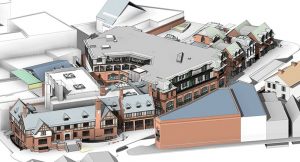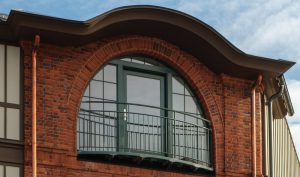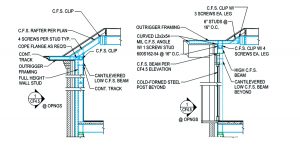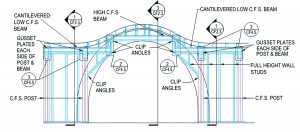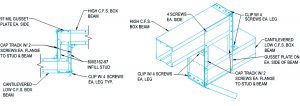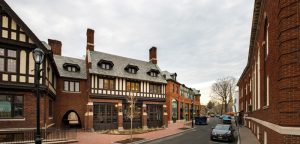Conventional Cold-Formed Steel Framing Solves Unconventional Problems
Design challenges often present themselves where a readymade solution is not available, and a unique solution using standard products must be designed. Various manufacturers in the cold-formed steel industry have developed a wide range of products, including unique clips and curved members. These products may have been designed to solve specific problems but, as new challenges are presented, a solution using standard products may be required. Such was the case on a renovation project in Westport, CT, where the versatility of conventional cold-formed steel framing was utilized to frame and support an architectural curved brick opening with cantilevered roof framing.
Project Summary
Bedford Square is a new mixed-use community in Westport which combines a renovated/converted historical Firehouse and 1920s-era Bedford Buildings with multiple new buildings ranging from two to four stories. The new, planned community will combine residential living with amenities such as public spaces, retail, and restaurants. The new additions, the Main and Gunn buildings, set out to match the historical architectural features of the original construction. In August of 2015, ADTEK Engineers began performing delegated design for the Bedford Square project for its client, Manganaro Northeast LLC, a drywall subcontractor in the New England area.
The Bedford Square project utilized a mixture of structural systems. Cold-formed steel framing was used throughout in a range of applications including non-load bearing and load bearing systems. Cold-formed steel framing was also used in various buildings as floor joists and roof rafters, for exterior skylight support, exterior concrete stair support framing with integrated planters, and exterior raised platforms. Additionally, plywood sheathed cold-formed steel shear walls were used as the lateral force resisting system for the new buildings.
This project had many unique architectural features, including a complex roof geometry with hips and valleys of varying slopes and curves, and several curved architectural openings and canopies. To support roof framing within the complex geometry, ADTEK relied heavily on proprietary clips and joist hangers from Simpson Strong-Tie and The Steel Network. The availability of design information, as well as the availability of manufacturer representatives, aided in the design of connections using the proprietary products. Specifying multiple manufacturers made it possible to use the correct clip or hanger for the correct application.
Using products from these manufacturers solved many problems; however, these products do have their limitations and may not be appropriate or provide a feasible solution for all applications. Understanding these limitations is critical to solving design issues.
The architect and engineer of record relied on the versatility of cold-formed steel framing to create curved framing that would support gravity and lateral wind loading. Various features were curved in either vertical or horizontal directions and with large radii, many times without supplementary structural support.
In most areas, ADTEK was able to design curved openings using straight headers with rigid framing. Where straight headers and rigid framing were not feasible, and a continuously curved header was required, ADTEK specified Radius Track at the curved headers.
Design Challenges
There were several design challenges that emerged due to the complex geometry and various specific features. One particular wall design challenge was a large brick “eyebrow” which was included as one of the balcony features in what is considered the Main building of Bedford Square. This opening created several challenges because it required an extremely large radius and the opening framing had to support the roof rafters.
This “eyebrow” opening was specifically challenging because the apex of the curved opening was higher than the roof rafters bearing on either side. The geometry of the opening and roof framing prevented a single straight header with rigid framing from being installed, so proprietary curved framing was investigated. Also challenging, as shown in the rendering, was the large radius originating at the floor level. The large length and radius necessitated the need for large heavy-gauge cold-formed steel members. Realizing the limitations of proprietary members, it was determined that they would not be feasible.
Solutions
To solve the design challenges, a series of headers and posts were used. As shown in the elevation, one high header, which supports the roof framing at the apex, and two low headers, which support the high header and the remaining roof framing, were provided. The low headers are supported by two cold-formed steel posts, one of which acts as the jamb stud to transfer lateral wind load to the roof diaphragm and the floor system. The low header cantilevers past the post/jamb member over a portion of the opening which allows the framing to provide support for the high header posts at the ends of the cantilever.
The lack of continuous framing around the opening created the issue of transferring lateral load from the feature back to the structure. The lower headers were located at or near the roof so that the lateral load could be transferred from the full height wall studs adjacent to the opening, the post/jamb studs, and a portion of the opening to the roof diaphragm. Similarly, the ends of the upper header were located at the roofline to transfer the lateral load from the opening into the diaphragm.
Once the transferring of the lateral load was solved, various aspects of the architectural features needed to be met. Stud infill framing and track members were used to partially make the curves of the opening. This supplemental framing was tied back to the beams and posts. Additionally, wood blocking was installed and connected back to the cold-formed steel framing to complete the curve.
Solving this design challenge emphasizes the importance of understanding various manufacturers’ limitations as well as proper detailing of unique conditions by the architect and engineer of record. Proprietary cold-formed steel products such as Radius Track, Simpson Strong-Tie, and The Steel Network can solve numerous design issues, but they also have their limitations. Radius Track made many of the curved openings and canopies on this project possible without requiring specialized details. Simpson Strong-Tie and The Steel Network provided clips and hangers that made designing connections to concrete, masonry, structural steel, and cold-formed steel much easier in many cases. Simpson Strong-Tie also provided assistance in hanger specification for numerous connections which required sloped and/or skewed geometries to achieve architectural features. Despite the versatility of both Simpson Strong-Tie and The Steel Network clips, there were still numerous areas which required specialized detailing to be able to achieve the complex geometry required at Bedford Square while still using proprietary clips.
Knowing the limitations of these products allows for creativity and highlights the versatility of conventional cold-formed steel framing. In this instance, a proprietary curved member was not feasible or desired by the client. Additionally, the complexity of the detail eliminated standard design methods and also eliminated the need for a curved structural steel member to be installed by another trade.
ADTEK was awarded 1st place for Cold-Formed Steel Engineers Institute (CFSEI) Design Excellence Category Award for its unique detailing and solution to this problem at the CFSEI Expo in Fort Worth, TX, in May of 2017.▪

